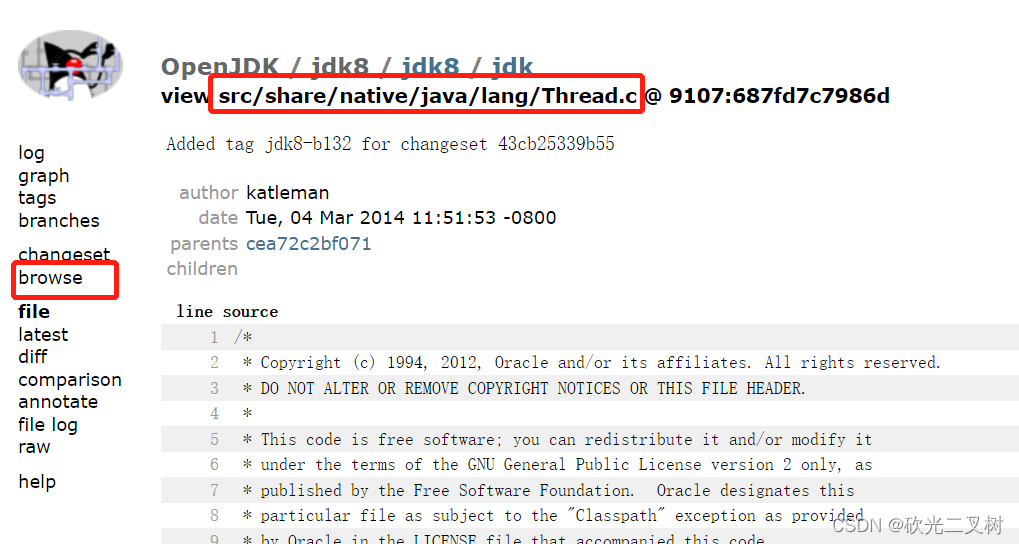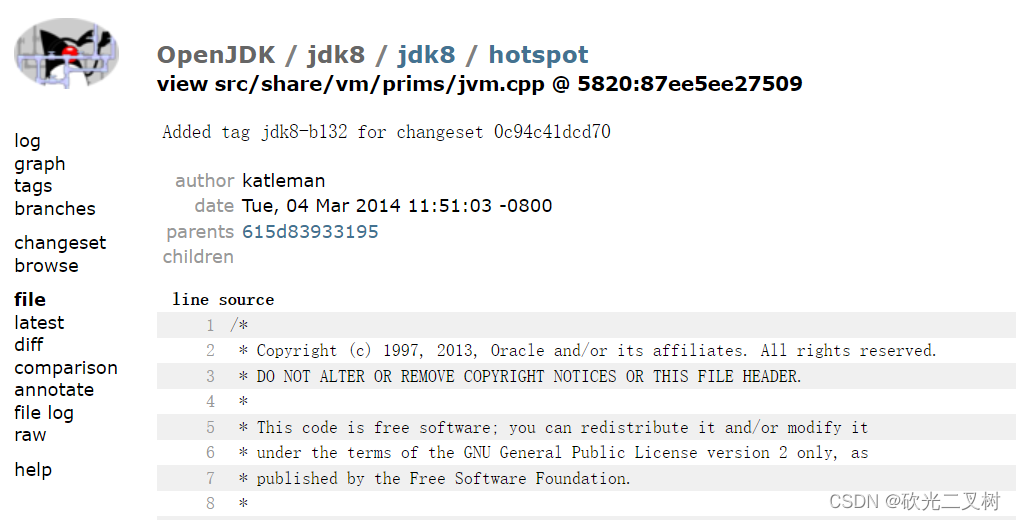一、Java怎么启动一个线程?
在 Java 中提供了两种方式去创建一个线程,但是不管那种方式,都需要调 start() 方法去启动一个线程。也有很多同学说 Java 有三种创建线程的方式,那么我们先看下 Thread 类上面的部分注释。
/**
* There are two ways to create a new thread of execution. One is to
* declare a class to be a subclass of <code>Thread</code>. This
* subclass should override the <code>run</code> method of class
* <code>Thread</code>. An instance of the subclass can then be
* allocated and started. For example, a thread that computes primes
* larger than a stated value could be written as follows:
* <hr><blockquote><pre>
* class PrimeThread extends Thread {
* long minPrime;
* PrimeThread(long minPrime) {
* this.minPrime = minPrime;
* }
*
* public void run() {
* // compute primes larger than minPrime
* . . .
* }
* }
* </pre></blockquote><hr>
* <p>
* The following code would then create a thread and start it running:
* <blockquote><pre>
* PrimeThread p = new PrimeThread(143);
* p.start();
* </pre></blockquote>
* <p>
* The other way to create a thread is to declare a class that
* implements the <code>Runnable</code> interface. That class then
* implements the <code>run</code> method. An instance of the class can
* then be allocated, passed as an argument when creating
* <code>Thread</code>, and started. The same example in this other
* style looks like the following:
* <hr><blockquote><pre>
* class PrimeRun implements Runnable {
* long minPrime;
* PrimeRun(long minPrime) {
* this.minPrime = minPrime;
* }
*
* public void run() {
* // compute primes larger than minPrime
* . . .
* }
* }
* </pre></blockquote><hr>
* <p>
* The following code would then create a thread and start it running:
* <blockquote><pre>
* PrimeRun p = new PrimeRun(143);
* new Thread(p).start();
* </pre></blockquote>
* <p>
*/
官方注释明确说明有两种方式创建一个线程,一种是继承 Thread 类,一种是实现 Runnable 接口,并且都给出了相应的代码示例。接下来我们看下 start() 的源码(删除了部分注释)。
/**
* Causes this thread to begin execution; the Java Virtual Machine
* calls the <code>run</code> method of this thread.
* <p>
* The result is that two threads are running concurrently: the
* current thread (which returns from the call to the
* <code>start</code> method) and the other thread (which executes its
* <code>run</code> method).
* <p>
* It is never legal to start a thread more than once.
* In particular, a thread may not be restarted once it has completed
* execution.
*
* @exception IllegalThreadStateException if the thread was already
* started.
*/
public synchronized void start() {
if (threadStatus != 0)
throw new IllegalThreadStateException();
group.add(this);
boolean started = false;
try {
start0();
started = true;
} finally {
try {
if (!started) {
group.threadStartFailed(this);
}
} catch (Throwable ignore) {
}
}
}
首先从方法的注释可以看出,该方法启动线程,然后 JVM 运行 run() 方法,并且该方法只能执行一次,重复执行会抛 IllegalThreadStateException 异常。
二、本地方法 start0()
进入方法的内部,可以看出执行了一个 start0() 方法,那么我们点开这个方法。
private native void start0();
该方法通过 native 修饰,是一个本地方法,那么我打开 JDK 官网去看下源码(官网地址)。选择 jdk8 之后选择 jdk, 然后点击Browse,在 src/share/native/java/lang 目录下找到 Thread.c 。

static JNINativeMethod methods[] = {
{"start0", "()V", (void *)&JVM_StartThread},
{"stop0", "(" OBJ ")V", (void *)&JVM_StopThread},
{"isAlive", "()Z", (void *)&JVM_IsThreadAlive},
{"suspend0", "()V", (void *)&JVM_SuspendThread},
{"resume0", "()V", (void *)&JVM_ResumeThread},
{"setPriority0", "(I)V", (void *)&JVM_SetThreadPriority},
{"yield", "()V", (void *)&JVM_Yield},
{"sleep", "(J)V", (void *)&JVM_Sleep},
{"currentThread", "()" THD, (void *)&JVM_CurrentThread},
{"countStackFrames", "()I", (void *)&JVM_CountStackFrames},
{"interrupt0", "()V", (void *)&JVM_Interrupt},
{"isInterrupted", "(Z)Z", (void *)&JVM_IsInterrupted},
{"holdsLock", "(" OBJ ")Z", (void *)&JVM_HoldsLock},
{"getThreads", "()[" THD, (void *)&JVM_GetAllThreads},
{"dumpThreads", "([" THD ")[[" STE, (void *)&JVM_DumpThreads},
{"setNativeName", "(" STR ")V", (void *)&JVM_SetNativeThreadName},
};
三、虚拟机函数 JVM_StartThread
通过源码可以看出,start0 方法调用了 JVM_StartThread 方法,很明显这是一个 JVM 提供的函数,那么我们看下这个函数,同样的步骤选择 jdk8 之后选择 hotspot, 然后点击Browse,在 src/share/vm/prims 目录下找到 jvm.cpp 。

JVM_ENTRY(void, JVM_StartThread(JNIEnv* env, jobject jthread))
JVMWrapper("JVM_StartThread");
JavaThread *native_thread = NULL;
bool throw_illegal_thread_state = false;
{
MutexLocker mu(Threads_lock);
if (java_lang_Thread::thread(JNIHandles::resolve_non_null(jthread)) != NULL) {
throw_illegal_thread_state = true;
} else {
jlong size =
java_lang_Thread::stackSize(JNIHandles::resolve_non_null(jthread));
size_t sz = size > 0 ? (size_t) size : 0;
native_thread = new JavaThread(&thread_entry, sz);
if (native_thread->osthread() != NULL) {
native_thread->prepare(jthread);
}
}
}
if (throw_illegal_thread_state) {
THROW(vmSymbols::java_lang_IllegalThreadStateException());
}
assert(native_thread != NULL, "Starting null thread?");
if (native_thread->osthread() == NULL) {
delete native_thread;
if (JvmtiExport::should_post_resource_exhausted()) {
JvmtiExport::post_resource_exhausted(
JVMTI_RESOURCE_EXHAUSTED_OOM_ERROR | JVMTI_RESOURCE_EXHAUSTED_THREADS,
"unable to create new native thread");
}
THROW_MSG(vmSymbols::java_lang_OutOfMemoryError(),
"unable to create new native thread");
}
Thread::start(native_thread);
JVM_END
我们可以看到两行重点代码:
- native_thread = new JavaThread(&thread_entry, sz), 创建线程;
- Thread::start(native_thread),启动线程。
那么我们在 src/share/vm/runtime 下找到 thread.cpp,点进去看下 JavaThread 的构造函数 new JavaThread(&thread_entry, sz) 和启动函数 Thread::start(native_thread) 。
JavaThread::JavaThread(ThreadFunction entry_point, size_t stack_sz) :
Thread()
#if INCLUDE_ALL_GCS
, _satb_mark_queue(&_satb_mark_queue_set),
_dirty_card_queue(&_dirty_card_queue_set)
#endif // INCLUDE_ALL_GCS
{
if (TraceThreadEvents) {
tty->print_cr("creating thread %p", this);
}
initialize();
_jni_attach_state = _not_attaching_via_jni;
set_entry_point(entry_point);
// Create the native thread itself.
// %note runtime_23
os::ThreadType thr_type = os::java_thread;
thr_type = entry_point == &compiler_thread_entry ? os::compiler_thread :
os::java_thread;
os::create_thread(this, thr_type, stack_sz);
_safepoint_visible = false;
}
void Thread::start(Thread* thread) {
trace("start", thread);
if (!DisableStartThread) {
if (thread->is_Java_thread()) {
java_lang_Thread::set_thread_status(((JavaThread*)thread)->threadObj(),
java_lang_Thread::RUNNABLE);
}
os::start_thread(thread);
}
}
四、总结
通过 os::create_thread 可以看出最终调用操作系统提供的 create_thread 创建线程,通过 os::start_thread 可以看出最终调用操作系统提供的 start_thread 启动线程。由此可得出结论:Java 线程和操作系统线程一一对应!























 776
776











 被折叠的 条评论
为什么被折叠?
被折叠的 条评论
为什么被折叠?










